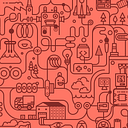Top 5 Characteristics of the Modern Digital Workplace
The digital workplace is a label that describes a shift in how we think about modern work as well as the tools we use to get work done. I like to think of it as the internal facing side of digital transformation. For an organization to be digital, they can’t only focus on their products and customer experiences. They must first look inward at their processes and employee experiences. The tools used are important too since they can either enable employees and productivity or hold them back.
Let’s look at what I consider the top five distinguishing features of the digital workplace and how each influences people, process, and technology.
1. Simple
First up, modern digital workplaces strive to simplify. Traditional organizational models, enterprise software, and workflows are typically overly complex and layered, resulting in inefficiency and steep learning curves. The modern workplace looks to create action oriented models of work that promote the responsibility of the worker and that circumvent slow, bureaucratic activities that don’t add value to the desired outcome.
2. Mobile
Mobility is a key component for the modern worker and workplace. Today’s world moves at a fast pace and today’s workforce has to be unrestrained from traditional desk and cubicle setups to keep up. The modern workplace has to yield flexibility in how, where, and when work takes place.
3. Social
Social media has changed the way we connect with people and ideas across the globe. Internal social applications and systems are no different in respect to allowing workers to connect with each other, to share thoughts and ideas, and enabling work to occur in a manner that is more natural and less hierarchical.
4. Open
The modern workforce expects openness and transparency in how they work and who they work with. Closeting away information and the rationale behind decisions won’t cut it when the rate of change is as high as it is today. Digital workplaces are fundamentally about enabling and empowering the free flow and exchange of ideas and information across traditional silos and organizational boundaries.
5. Smart
Advancements in machine learning, deep learning, and artificial intelligence are occurring at a quickening pace, bringing with them practical applications for the workplace. It isn’t just about smart tech though. Mindsets have to evolve to embrace how we can leverage advanced technologies to change the way work is done. A smart workforce, carrying out smart processes, augmented by smart applications and technologies will be the driving force behind the next leap in productivity.
Below are just a few examples of how the digital workplace challenges how we think, design, organize, and get work down in today’s modern enterprise.
If you liked this post, follow me or my Business as Unusual publication here on Medium or Twitter.

